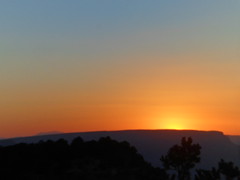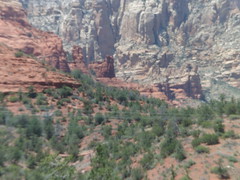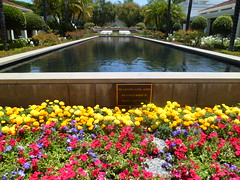The warning sign is very clear: “Down is optional. Up is mandatory”. I was determined I would get to the Colorado River and back, within one 24-hour time period. There are things one can do to make that happen- drink the water that is available at three locations along the way, soak the shirt and hat, copiously. (Women can do this, discretely, and most of us men are gentlemanly enough to turn ourselves away). Lastly, take advantage of the four rest houses and numerous rock overhangs that provide shade.
I set out from Mather Campground at 6:30 A.M., on Wednesday, the “Longest Day” of the northern year. Greeting several of us at the trailhead were a pair of elk.

The little boy on the right was my steadfast friend on the first 1/2 mile of the hike. Then he fell back to rejoin his father.
There are 21 more photos in this post. Bear with me.

I started off in earnest at 7:00 A.M.

The top layers are Kaibab and Toroweap Limestone, respectively. Toroweap makes the sheer wall one sees just below the surface.

A few big horn sheep were keeping us company during the first half mile. There were also mule deer, which were a lot more skittish.


We pass through two windows within the first mile of the trail. Next are two views of the Toroweap Limestone wall.

Not far away, I spotted the 1.5 Mile Rest House. This is very welcome in the afternoon! Below is a close-up of the rest house. Those at 3 Mile, Indian Garden and Pipe Creek are quite similar. Water is available at the first three, and all four have toilets.

Below 1.5 Mile, there is a solid layer of Coconino Sandstone.

As I neared Indian Garden, an NPS helicopter landed. This appeared to be a wild animal transfer of some kind. The ranger had his tranquilizer gun out, so it may have been a mountain lion, which would not have been welcome at Indian Garden Campground!


The Colorado Plateau is largely desert, at its lower elevations. Indian Garden offers a lush oasis, for about 1 1/2 miles, along Garden Creek.

Above, Undivided Dolomite and Mujav Limestone are your hosts, heading from Indian Garden to Devil’s Corkscrew. This rock layer is from the Cambrian Era.
Garden Creek remains a friendly helper, for about a mile past Indian Garden.

Devil’s Corkscrew is a mixture of Zoroaster Granite, Nankoweap Sandstone and Gardenas Lava. Dox Sandstone makes up the bottom layer, where one gets to Pipe Creek. This is a 2.5 segment of extreme desert, with triple digit temperatures in the afternoon. Be fit, or turn around!

I took this from underneath a rock overhang, along the Corkscrew. This postpile is of Dox Sandstone.

The emergence of Pipe Creek, and the presence of blue dashers, signal that the river is close by. I tried to encourage a couple of ladies to keep going the last mile or so. Apparently, they’d had enough. A man who came by while I was at Pipe Creek Resthouse said he saw them soak their shirts and head back towards the Corkscrew. I never saw them after that, so they made it out. Always follow your gut, in these situations.

At 11;30 A.M., I reached the Colorado River, at Pipe Beach. The rock you see along the north bank is Bass Limestone and Vishnu Schist. This is all the legacy of Pre-Cambrian Earth, when everything lived underwater.

I rested, had lunch and soaked my feet at Pipe Creek Resthouse, after chatting with a couple who were kind enough to record my presence (above), and taking their photos, in turn. It took from 12:15 to 6:38 P.M. to return from the river to the rim. There were confirmations along the way, and I was constantly reminded of confirmations that I would be just fine. One of those was a heart-shaped prickly pear cactus.

Here are the Navajo Sandstone and Toroweap Limestone layers, in late afternoon.

I had the good fortune to meet up with three people from Tusayan, when I got to 3-Mile Rest House. They pretty much stayed with me the rest of the way. It was their first Canyon hike, and two of them said it would be their last. I would be surprised if that were the case. Cooler weather brings a much different Grand Canyon experience.
I cannot say enough good about the rangers. These are among the hardest-working young people I’ve ever seen. They keep very close watch on hikers, and will be the adults in the room, when one’s judgment gets cloudy. I got through the Longest Day by following their guidelines. Though traveling rim to river and back on foot is discouraged, it can be done- if one is in good shape, takes his/her time and stays hydrated.










































































































